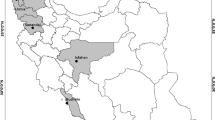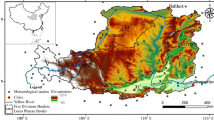Abstract
Accurate estimation of evapotranspiration is important for ecological protection, rational allocation and utilization of water resources, especially in hyper-arid areas where meteorological data is lacking. The Hotan River Basin and Oasis, at the southern edge of Tarim Basin (TB) in Xinjiang, China, is characterized by dry climate and low precipitation. In this study, the temporal and spatial variations in evapotranspiration from 1979–2018 in Hotan River Basin and Oasis were calculated viathe improved nonlinear evaporation complementary relationship model that proposed by Brutsaert (B2015 model). Then, the Mann–Kendall (M–K) trend test and Sen’s slope regression were used to analyze the trend of evapotranspiration in this region. The results showed that (1) the improved B2015 model was appropriate for calculating the evapotranspiration in Hotan River Basin and Oasis, with a determination coefficient of 0.91. (2) The average evapotranspiration in this region was 398.73 mm/y from 1979–2018. The highest evapotranspiration rate (65.00 mm/month) and lowest evapotranspiration rate (5.29 mm/month) occurred in June and January, respectively. The area with a significant increase trend in evapotranspiration accounted for 53.53%, and the area with a significant decrease accounted for 5.04%. (3) Furthermore, the evapotranspiration decreased with the increased altitude. Temperature and humidity were the main factors affecting evapotranspiration in this region. These results can provide a reference for evapotranspiration calculation and hydrological process research in hyper-arid areas.






Similar content being viewed by others
Data Availability
The datasets used and/or analyzed during the current study are available from the corresponding author on reasonable request.
References
Ai ZP, Wang QX, Yang YH, Manevski K, Zhao X, Eer DN (2017) Estimation of land-surface evaporation at four forest sites across Japan with the new nonlinear complementary method. Sci Rep 7(8):17793. https://doi.org/10.1038/s41598-017-17473-0
Bouchet RJ (1963) Evapotranspiration réelle, evapotranspiration potentielle, et production agricole. Ann Agron 14:743–824
Brutsaert W (2015) A generalized complementary principle with physical constraints for land-surface evaporation. Water Resour Res 51:8087–8093. https://doi.org/10.1002/2015wr017720
Brutsaert W, Stricker H (1979) Advection-aridity approach to estimate actual regional evapotranspiration. Water Resour Res 15:443–450. https://doi.org/10.1029/WR015i002p00443
Chen X, Buchberger SG (2018) Exploring the relationships between warm-season precipitation, potential evaporation, and “apparent” potential evaporation at site scale. Hydrol Earth Syst Sci 22:4535–4545. https://doi.org/10.5194/hess-22-4535-2018
da Costa EMB, Lucio PS, Maia AG (2021) Relevance of reservoir morphometry in the evaporation process: an evaporation model for semi-arid regions. Water Resour Manag 35:4895–4907. https://doi.org/10.1007/s11269-021-02978-1
Granger RJ, Gray DM (1989) Evaporation from natural nonsaturated surfaces. J Hydrol 111:21–29. https://doi.org/10.1016/0022-1694(89)90249-7
Han SJ, Tian FQ, Wang W, Wang LM (2021) Sigmoid generalized complementary equation for evaporation over wet surfaces: a nonlinear modification of the Priestley-Taylor equation. Water Resour Res 57:32. https://doi.org/10.1029/2020wr028737 (e2020WR028737)
Huo ZL, Dai XQ, Feng SY, Kang SZ, Huang GH (2013) Effect of climate change on reference evapotranspiration and aridity index in arid region of China. J Hydrol 492:24–34. https://doi.org/10.1016/j.jhydrol.2013.04.011
Jiang YS, Liu ZF (2022) Simulation of actual evapotranspiration and evaluation of three complementary relationships in three parallel River Basins. Water Resour Manag 36:5107–5126. https://doi.org/10.1007/s11269-022-03294-y
Jin XM, Guo RH, Xia W (2013) Distribution of actual evapotranspiration over Qaidam Basin, an arid area in China. Remote Sens 5:6976–6996. https://doi.org/10.3390/rs5126976
Kuang XX, Jiao JJ (2016) Review on climate change on the Tibetan Plateau during the last half century. J Geophys Res-Atmos 121:3979–4007. https://doi.org/10.1002/2015jd024728
Li PF, Yang G, He XL, Li FD, Yan K, Wang ZL (2019) Effects of drip irrigation on components of water cycle in arid inland areas: A case study of Manas river basin in northwestern China. Int J Agric Biol Eng 12:132–138. https://doi.org/10.25165/j.ijabe.20191201.4031
Lian X, Piao SL, Li LZX, Li Y, Huntingford C, Ciais P, Cescatti A, Janssens IA, Penuelas J, Buermann W et al (2020) Summer soil drying exacerbated by earlier spring greening of northern vegetation. Sci Adv 6:11. https://doi.org/10.1126/sciadv.aax0255 (eaax0255)
Liu ZF, Yao ZJ, Wang R (2019) Simulation and evaluation of actual evapotranspiration based on inverse hydrological modeling at a basin scale. Catena 180:160–168. https://doi.org/10.1016/j.catena.2019.03.039
Ma N, Szilagyi J, Zhang YS, Liu WB (2019) Complementary-relationship-based modeling of terrestrial evapotranspiration across China during 1982–2012: validations and spatiotemporal analyses. J Geophys Res-Atmos 124:4326–4351. https://doi.org/10.1029/2018jd029850
Maes WH, Steppe K (2012) Estimating evapotranspiration and drought stress with ground-based thermal remote sensing in agriculture: a review. J Exp Bot 63:4671–4712. https://doi.org/10.1093/jxb/ers165
Majidi M, Alizadeh A, Vazifedoust M, Farid A, Ahmadi T (2015) Analysis of the effect of missing weather data on estimating daily reference evapotranspiration under different climatic conditions. Water Resour Manag 29:2107–2124. https://doi.org/10.1007/s11269-014-0782-0
McMahon TA, Peel MC, Lowe L, Srikanthan R, McVicar TR (2013) Estimating actual, potential, reference crop and pan evaporation using standard meteorological data: a pragmatic synthesis. Hydrol Earth Syst Sci 17:1331–1363. https://doi.org/10.5194/hess-17-1331-2013
Miralles DG, Holmes TRH, De Jeu RAM, Gash JH, Meesters A, Dolman AJ (2011) Global land-surface evaporation estimated from satellite-based observations. Hydrol Earth Syst Sci 15:453–469. https://doi.org/10.5194/hess-15-453-2011
Ravindran SM, Bhaskaran SKM, Ambat SKN (2021) A Deep neural network architecture to model reference evapotranspiration using a single input meteorological parameter. Environ Process 8:1567–1599. https://doi.org/10.1007/s40710-021-00543-x
Rosenberry DO, Winter TC, Buso DC, Likens GE (2007) Comparison of 15 evaporation methods applied to a small mountain lake in the northeastern USA. J Hydrol 340:149–166. https://doi.org/10.1016/j.jhydrol.2007.03.018
Tabari H, Marofi S, Aeini A, Talaee PH, Mohammadi K (2011) Trend analysis of reference evapotranspiration in the western half of Iran. Agric for Meteorol 151:128–136. https://doi.org/10.1016/j.agrformet.2010.09.009
Wang C, Wang S, Fu BJ, Zhang L (2016) Advances in hydrological modelling with the Budyko framework: A review. Prog Phys Geogr 40:409–430. https://doi.org/10.1177/0309133315620997
Yan D, Lai ZZ, Ji GX (2020) Using Budyko-Type equations for separating the impacts of climate and vegetation change on runoff in the source area of the Yellow River. Water 12(15):3418. https://doi.org/10.3390/w12123418
Yang WJ, Wang YB, Liu X, Zhao HP, Shao R, Wang GX (2020a) Evaluation of the rescaled complementary principle in the estimation of evaporation on the Tibetan Plateau. Sci Total Environ 699:134367. https://doi.org/10.1016/j.scitotenv.2019.134367
Yang WJ, Wang YB, Liu X, Zhao HP, Wang GX, Shao R (2020b) Estimating the evaporation in the Fenghuo Mountains permafrost region of the Tibetan Plateau. Catena 194(9):104754. https://doi.org/10.1016/j.catena.2020.104754
Zhang K, Kimball JS, Running SW (2016) A review of remote sensing based actual evapotranspiration estimation. Wiley Interdiscip Rev Water 3:834–853. https://doi.org/10.1002/wat2.1168
Zhang L, Cheng L, Brutsaert W (2017) Estimation of land surface evaporation using a generalized nonlinear complementary relationship. J Geophys Res Atmos 122:1475–1487. https://doi.org/10.1002/2016jd025936
Zheng YR, Xie ZX, Roberts C, An P, Li XJ, Zhou GS, Shimizu H, Drake S (2011) Modelling seasonal evapotranspiration of arid lands in China. Hydrol Res 42:40–49. https://doi.org/10.2166/nh.2010.042
Zheng J, Fan JL, Zhang FC, Zhuang QL (2021) Evapotranspiration partitioning and water productivity of rainfed maize under contrasting mulching conditions in Northwest China. Agric Water Manag 243(16):106473. https://doi.org/10.1016/j.agwat.2020.106473
Funding
This work was supported by the National Natural Science Foundation of China (42171042), Tianshan Innovation Team of Xinjiang (2020D14042) and Special Foundation for National Science and Technology Basic Research Program of China (2019FY100205).
Author information
Authors and Affiliations
Contributions
All authors contributed to the study. Y. F. Liu and D. W. Gui designed the framework for the analysis. F. J. Zeng, D. W. Gui and Y. Liu provided the data. C. J. Yin, L. Zhang and D. P. Xue conducted data curation. Y. F. Liu conducted the analysis and wrote the manuscript in consultation with Z. Ahmed and X. P. Chen, who provided valuable insights. All authors read and approved the final manuscript.
Corresponding author
Ethics declarations
Competing Interests
The authors have no relevant financial or nonfinancial interests to disclose.
Additional information
Publisher's Note
Springer Nature remains neutral with regard to jurisdictional claims in published maps and institutional affiliations.
Rights and permissions
Springer Nature or its licensor (e.g. a society or other partner) holds exclusive rights to this article under a publishing agreement with the author(s) or other rightsholder(s); author self-archiving of the accepted manuscript version of this article is solely governed by the terms of such publishing agreement and applicable law.
About this article
Cite this article
Yunfei, L., Dongwei, G., Changjun, Y. et al. Estimating the Temporal and Spatial Variations in Evapotranspiration with a Nonlinear Evaporation Complementary Relationship Model in Hyper-arid Areas. Water Resour Manage 37, 521–535 (2023). https://doi.org/10.1007/s11269-022-03384-x
Received:
Accepted:
Published:
Issue Date:
DOI: https://doi.org/10.1007/s11269-022-03384-x




